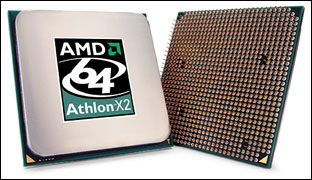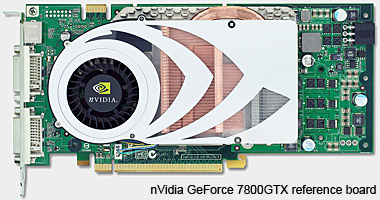Daniel Sevo's PC buyers guide
Section 3: Demanding hardwareCategories 5 & 6This is where you should be more careful with your purchase. While any new computer will allow you to to do most of the things in categories 1 to 4 (see section 1), they are often not aimed at true gamers or people who will use their computer for heavy graphics work. To get the most out of hardware demanding games such as Far Cry, Doom 3, Half-Life 2, F.E.A.R. (and other yet unrealeased cool new games such as Unreal 3), you will need a fast CPU and a very good graphics card. Current situation and recent historyThe CPU 
Many resellers sell Celeron based computers because these processors are very cheap and it lowers the price of the entire system. These CPU:s are aimed at the low end market and they are good enough for most stuff in cat 1-4. AMD now offers the Sempron as a low price alternative, replacing the old Duron which has been phased out. The early Semprons were actually just renamed Athlon XPs which have been superseded by the Athlon 64. The new Semprons are basically Athlon 64s with slower clock speeds and smaller L2 caches. With the arrival of dual-core CPUs, it's likely that the single core CPUs will become the new "budget" chips (both AMD and Intel). Some of you may have noticed that AMD uses a performance rating on their CPUs rather than actual speed in MHz/GHz. From AMD's point of view this is an understandable strategy, since there is more to a CPU's performance than just MHz speed. Intel designed the Pentium 4 for high frequencies because they knew that 90% of the consumers only look at MHz. To put it simply, AMD's CPUs perform more operations each clock-cycle, so they don't need to run as fast as P4s to match their actual performance. Intel's next architecture is a step back to a more efficient (shorter) pipeline (similar to the Pentium M). Real-world example: You and your friend are playing basketball. You can throw 20 times a minute but the way you throw means you only score 50% of the time. (10 shots scored=20 points). Your friend throws slower than you. Only 12 times per minute, but he scores 90% of his shots. (11 out of 12 shots= 22 points) So even though you throw faster, after one minute of throwing, your friend has scored more points than you. Remember, it's not just how fast you do thing, but how well you do them... Since this section is aimed at demanding users, let's take a look at the best stuff that is out there at this point. It's been a while since AMD launched its line of 64-bit desktop CPUs and even though Intel needed some time to catch up, both vendors now offer 64-bit CPUs across the range. Although one might think that performance increases have stagnated over the past few years, it need to be said that CPU makers now aim for multi-core technology, not necessarily extreme clock-speeds. For now, AMD's "Athlon 64 FX" -series is the CPU of choice among (rich) enthusiasts. It's currently the best CPU for games and a very strong all-around performer. However, in the section below (Near future) I'll mention Intel's upcoming CPU architecture called "Core" which looks very promising. Unless you are an enthusiast with deep pockets or you buy a whole computer fully assembled, you should give the FX a miss. The Athlon 64 X2 on Socket 939 is quite competitive anyway and cheaper that the FX version. The X2 stands for dual-core. Intel also offer dual core Pentiums (Socket 775 Pentium D, "Pressler core"). Dual core chips bring the attractive multiprocessing power previously typically only available in more expensive workstations (requirering motherboards with two CPU slots, and special versions (=expensive) of multiprocssing-capable CPUs. The reason why this complicates things (as opposed to only making it better) is because the software most of us run today (this is especially true for games) is not designed to take advantage of a multi-processing environment. However, even though almost no games will care much about a dual-core CPU, there is a lot of software that will most definitely benefit a great deal from running on a dual-core processor. This is typically true for all kinds of 3D graphics tools (such as 3dsmax, Maya, Lightwave etc) but also other types of encoding software and so on. (Windows will also feel more responsive, but expect miracles. Hopefully, Windows VIsta will have more clever thread/process handling than Win XP.) The graphics card 
Even more important than the CPU, for a gamer, is the 3D graphics card. When Quake 1 arrived back in the summer of 1996, there was barely such a thing as a 3D graphics card for a PC. They were typically only seen in expensive Silicon Graphics computer workstations. The 3D was entirely handled by the the main processor, the CPU and games ran on what was known as a software renderer. Later that year however, the first 3D graphics accelerators (or multimedia accelerators as some called them) entered the PC market. Now, a decade later, the graphics chips are more complex than the CPU:s. nVidia Corporation is a company that has been in the PC 3D market from the beginning (although with a small market share back in the mid-90's). In 2002 they were definitely the 'king of the hill (which they became in 2000) but in 2003, Canadian firm ATI (which have also been in the biz "from the beginning" became a very tough competitor. Both companies offer GPU (Graphics Processing Unit) chips that are incredibly powerful and offer performance only recently seen in million dollar workstations. With new models coming out every 6 months or so, it's impossible to say for sure which is the best card to buy. nVidia made a powerful comeback in 2004 with it's GeForce 6800 series and for a while it had the edge over ATI. Since then nVidia released the 7xxx series (codenamed G70, G71) (the base for the Playstation 3 graphics chip) and ATI has release the X1xx (codenamed R520) series with Xbox360-class graphics. Both companies constantly push the technology to it's limits. The good news for us consumers is that old but still perfectly adequate GFX cards quickly drop in price, making them very affordable. So what is actually the best buy in first half of 2006? If you are a hardcore gamer, nVidia's GeForce 7900 GTX and GT models offer excellent performance as does ATI's X1900 XT. Both companies also offer dual-card configuration technology. In nVidia's case, it's called SLI (Scalable Link Interface) and ATI's counterpart is known as CrossFire. What it means is that you can buy two top of the line cards and put them onto your motherboard (which needs to have dual PCI Express slots and support either SLI or CrossFire). When paired with a dual-core CPU, this will make a very powerfull computer indeed, by far outclassing any old SGI multimillion dollar workstation you can think of. At CeBIT 2006, nVidia showed their new Quad SLI technology which allows 4 GPUs to work in parallel. While interesting, many people ask themselves if Quad SLI really is necessary or even useful. Tests indicate that on a Quad SLI setup, games become CPU limited, meaning the GPUs don't get effectively utilized. Quad core CPUs are coming, but not fo a while. If you can't afford the latest and the greatest, look for the good prices on the previous top-of-the-line generation or maybe the cheaper midrange 7800-class cards (GeForce 7800 GT/GS). The same reasoning applies to ATI cards. The previous generation's top-of-the-line models are usually more powerful than the latest generation's mid-range cards. However! Don't forget to make sure that the graphics card uses the same connection tech as your motherboard. Buying an AGP card for your PCI-Express motherboard is a very bad idea. If you're buying a whole new computer, then just make sure you get PCIe, but if you are someone who likes to upgrade their computer one piece at a time, then you could be in for a dilemma. If you just bought an expensive AGP based GFX card (as I did), then I suggest you grab the best AGP mother board you can find and settle for that. But if you have an aging GFX card and want to buy a new one, then maybe it's time to consider a bigger upgrade with a new motherboard, CPU, GFX card and probably memory. Near FutureCPU:This section describes the products that are in development but not yet released. This is of course something that very often affect your choice of product. (The "Coming soon" dilemma described in Section 1.) Nevertheless, the fact is that sometimes it's a good idea to wait for a new generation of products to arrive. if you have a computer that is OK and you can without problems continue to use it for another 6 months then you might be interested in the stuff that lies "around the corner". On June 6th 2006 (6/6/6) AMD will release their next socket, the 940-pin "Socket AM2". What this will bring to the AMD platform is support for DDR2 and maybe even DDR3 memory (along with a few other tweaks). Although Socket 939 is fine with dual core support and so on, it can't handle DDR2 memory. It's not a problem today, but it might become noticeable within a few years.) Socket AM2 CPUs will also support "Virtualization" technology (which allows you to run multiple Operating Systems on the same CPU). THen, sometimes in the 3rd or 4th quarter (2006) Intel will launch their next generation CPU architecture. I don't know yet if they will finally ditch the Pentium name but Intel calls their new CPU architecture "Core". This architecture is similar to the Pentium M and a step away from the long pipeline/high frequency Pentium 4 NetBurst architecture. Early tests indicate that this new architecture performs very well and AMD might, after some years of performance dominance "finally find themselves beaten by a fair margin. Although, a new architecture usually beats the old ones, then the competition needs some time to retaliate. For the past 2 years, AMD have clearly been the better choice for gamers, yet people still continued to buy Intel CPUs, so it's difficult to speculate how things will shape up once Intel release this new "Conroe" (codename) CPU. AMD are also lagging behind Intel with 65nm technology. Intel already sell 65nm chips, while AMD might not get their die-shrunk chips out until the later part of the year. At that point, they might update the Athlon 64 core with a new revision to better counter Intel's "Conroe" CPU. According to some sources, AMD will counter Conroe in 2007. Another way to compete is by lowering prices making the products more attractive. As always, tough competition is usually good for the consumers. Graphics: How about the graphics market then? Well, we can be sure that nVidia and ATI will keep their tight release schedule, however, with the recent release of Quad SLI a new graphics card doesn't sound all that... hmm.. necessary.. So what if the new card is twice as fast as the previous generation if you already have a quad set-up, right? Well, first of all, the software industry need to catch-up with the hardware makers nVidia and ATI. Because if this continues we'll all be sitting at home with graphics power that by far exceeds anything we actually need. To sum it up: If you have a decent setup, wait for AMDs Socket AM2 or Intel's "Conroe". As far as graphics cards are concerned, just go for something that suits your pocket as most high end cards are perfectly adequate for any game you can think of. Section 4: Links to other buyers guides. |

Return Home |